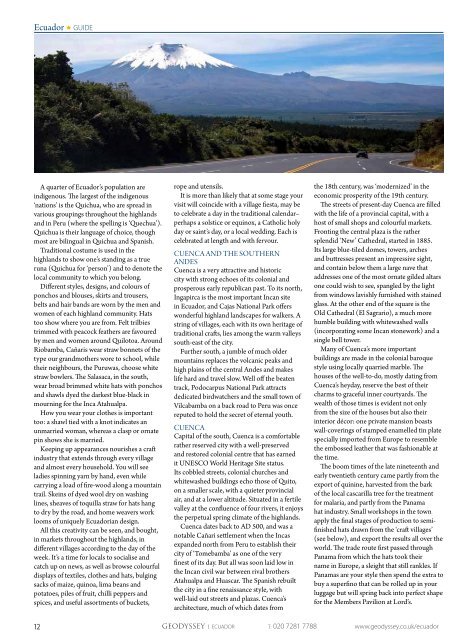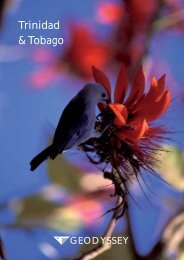Ecuador and the Galapagos Islands - Geodyssey
Ecuador and the Galapagos Islands - Geodyssey
Ecuador and the Galapagos Islands - Geodyssey
You also want an ePaper? Increase the reach of your titles
YUMPU automatically turns print PDFs into web optimized ePapers that Google loves.
<strong>Ecuador</strong> ê GUIDE<br />
A quarter of <strong>Ecuador</strong>’s population are<br />
indigenous. The largest of <strong>the</strong> indigenous<br />
‘nations’ is <strong>the</strong> Quichua, who are spread in<br />
various groupings throughout <strong>the</strong> highl<strong>and</strong>s<br />
<strong>and</strong> in Peru (where <strong>the</strong> spelling is ‘Quechua’).<br />
Quichua is <strong>the</strong>ir language of choice, though<br />
most are bilingual in Quichua <strong>and</strong> Spanish.<br />
Traditional costume is used in <strong>the</strong><br />
highl<strong>and</strong>s to show one’s st<strong>and</strong>ing as a true<br />
runa (Quichua for ‘person’) <strong>and</strong> to denote <strong>the</strong><br />
local community to which you belong.<br />
Different styles, designs, <strong>and</strong> colours of<br />
ponchos <strong>and</strong> blouses, skirts <strong>and</strong> trousers,<br />
belts <strong>and</strong> hair b<strong>and</strong>s are worn by <strong>the</strong> men <strong>and</strong><br />
women of each highl<strong>and</strong> community. Hats<br />
too show where you are from. Felt trilbies<br />
trimmed with peacock fea<strong>the</strong>rs are favoured<br />
by men <strong>and</strong> women around Quilotoa. Around<br />
Riobamba, Cañaris wear straw bonnets of <strong>the</strong><br />
type our gr<strong>and</strong>mo<strong>the</strong>rs wore to school, while<br />
<strong>the</strong>ir neighbours, <strong>the</strong> Puruwas, choose white<br />
straw bowlers. The Salasaca, in <strong>the</strong> south,<br />
wear broad brimmed white hats with ponchos<br />
<strong>and</strong> shawls dyed <strong>the</strong> darkest blue-black in<br />
mourning for <strong>the</strong> Inca Atahualpa.<br />
How you wear your clo<strong>the</strong>s is important<br />
too: a shawl tied with a knot indicates an<br />
unmarried woman, whereas a clasp or ornate<br />
pin shows she is married.<br />
Keeping up appearances nourishes a craft<br />
industry that extends through every village<br />
<strong>and</strong> almost every household. You will see<br />
ladies spinning yarn by h<strong>and</strong>, even while<br />
carrying a load of fire-wood along a mountain<br />
trail. Skeins of dyed wool dry on washing<br />
lines, sheaves of toquilla straw for hats hang<br />
to dry by <strong>the</strong> road, <strong>and</strong> home weavers work<br />
looms of uniquely <strong>Ecuador</strong>ian design.<br />
All this creativity can be seen, <strong>and</strong> bought,<br />
in markets throughout <strong>the</strong> highl<strong>and</strong>s, in<br />
different villages according to <strong>the</strong> day of <strong>the</strong><br />
week. It’s a time for locals to socialise <strong>and</strong><br />
catch up on news, as well as browse colourful<br />
displays of textiles, clo<strong>the</strong>s <strong>and</strong> hats, bulging<br />
sacks of maize, quinoa, lima beans <strong>and</strong><br />
potatoes, piles of fruit, chilli peppers <strong>and</strong><br />
spices, <strong>and</strong> useful assortments of buckets,<br />
rope <strong>and</strong> utensils.<br />
It is more than likely that at some stage your<br />
visit will coincide with a village fiesta, may be<br />
to celebrate a day in <strong>the</strong> traditional calendar–<br />
perhaps a solstice or equinox, a Catholic holy<br />
day or saint’s day, or a local wedding. Each is<br />
celebrated at length <strong>and</strong> with fervour.<br />
Cuenca <strong>and</strong> <strong>the</strong> sou<strong>the</strong>rn<br />
Andes<br />
Cuenca is a very attractive <strong>and</strong> historic<br />
city with strong echoes of its colonial <strong>and</strong><br />
prosperous early republican past. To its north,<br />
Ingapirca is <strong>the</strong> most important Incan site<br />
in <strong>Ecuador</strong>, <strong>and</strong> Cajas National Park offers<br />
wonderful highl<strong>and</strong> l<strong>and</strong>scapes for walkers. A<br />
string of villages, each with its own heritage of<br />
traditional crafts, lies among <strong>the</strong> warm valleys<br />
south-east of <strong>the</strong> city.<br />
Fur<strong>the</strong>r south, a jumble of much older<br />
mountains replaces <strong>the</strong> volcanic peaks <strong>and</strong><br />
high plains of <strong>the</strong> central Andes <strong>and</strong> makes<br />
life hard <strong>and</strong> travel slow. Well off <strong>the</strong> beaten<br />
track, Podocarpus National Park attracts<br />
dedicated birdwatchers <strong>and</strong> <strong>the</strong> small town of<br />
Vilcabamba on a back road to Peru was once<br />
reputed to hold <strong>the</strong> secret of eternal youth.<br />
Cuenca<br />
Capital of <strong>the</strong> south, Cuenca is a comfortable<br />
ra<strong>the</strong>r reserved city with a well-preserved<br />
<strong>and</strong> restored colonial centre that has earned<br />
it UNESCO World Heritage Site status.<br />
Its cobbled streets, colonial churches <strong>and</strong><br />
whitewashed buildings echo those of Quito,<br />
on a smaller scale, with a quieter provincial<br />
air, <strong>and</strong> at a lower altitude. Situated in a fertile<br />
valley at <strong>the</strong> confluence of four rivers, it enjoys<br />
<strong>the</strong> perpetual spring climate of <strong>the</strong> highl<strong>and</strong>s.<br />
Cuenca dates back to AD 500, <strong>and</strong> was a<br />
notable Cañari settlement when <strong>the</strong> Incas<br />
exp<strong>and</strong>ed north from Peru to establish <strong>the</strong>ir<br />
city of ‘Tomebamba’ as one of <strong>the</strong> very<br />
finest of its day. But all was soon laid low in<br />
<strong>the</strong> Incan civil war between rival bro<strong>the</strong>rs<br />
Atahualpa <strong>and</strong> Huascar. The Spanish rebuilt<br />
<strong>the</strong> city in a fine renaissance style, with<br />
well-laid out streets <strong>and</strong> plazas. Cuenca’s<br />
architecture, much of which dates from<br />
<strong>the</strong> 18th century, was ‘modernized’ in <strong>the</strong><br />
economic prosperity of <strong>the</strong> 19th century.<br />
The streets of present-day Cuenca are filled<br />
with <strong>the</strong> life of a provincial capital, with a<br />
host of small shops <strong>and</strong> colourful markets.<br />
Fronting <strong>the</strong> central plaza is <strong>the</strong> ra<strong>the</strong>r<br />
splendid ‘New’ Ca<strong>the</strong>dral, started in 1885.<br />
Its large blue-tiled domes, towers, arches<br />
<strong>and</strong> buttresses present an impressive sight,<br />
<strong>and</strong> contain below <strong>the</strong>m a large nave that<br />
addresses one of <strong>the</strong> most ornate gilded altars<br />
one could wish to see, spangled by <strong>the</strong> light<br />
from windows lavishly furnished with stained<br />
glass. At <strong>the</strong> o<strong>the</strong>r end of <strong>the</strong> square is <strong>the</strong><br />
Old Ca<strong>the</strong>dral (El Sagrario), a much more<br />
humble building with whitewashed walls<br />
(incorporating some Incan stonework) <strong>and</strong> a<br />
single bell tower.<br />
Many of Cuenca’s more important<br />
buildings are made in <strong>the</strong> colonial baroque<br />
style using locally quarried marble. The<br />
houses of <strong>the</strong> well-to-do, mostly dating from<br />
Cuenca’s heyday, reserve <strong>the</strong> best of <strong>the</strong>ir<br />
charms to graceful inner courtyards. The<br />
wealth of those times is evident not only<br />
from <strong>the</strong> size of <strong>the</strong> houses but also <strong>the</strong>ir<br />
interior décor: one private mansion boasts<br />
wall-coverings of stamped enamelled tin plate<br />
specially imported from Europe to resemble<br />
<strong>the</strong> embossed lea<strong>the</strong>r that was fashionable at<br />
<strong>the</strong> time.<br />
The boom times of <strong>the</strong> late nineteenth <strong>and</strong><br />
early twentieth century came partly from <strong>the</strong><br />
export of quinine, harvested from <strong>the</strong> bark<br />
of <strong>the</strong> local cascarilla tree for <strong>the</strong> treatment<br />
for malaria, <strong>and</strong> partly from <strong>the</strong> Panama<br />
hat industry. Small workshops in <strong>the</strong> town<br />
apply <strong>the</strong> final stages of production to semifinished<br />
hats drawn from <strong>the</strong> ‘craft villages’<br />
(see below), <strong>and</strong> export <strong>the</strong> results all over <strong>the</strong><br />
world. The trade route first passed through<br />
Panama from which <strong>the</strong> hats took <strong>the</strong>ir<br />
name in Europe, a sleight that still rankles. If<br />
Panamas are your style <strong>the</strong>n spend <strong>the</strong> extra to<br />
buy a superfino that can be rolled up in your<br />
luggage but will spring back into perfect shape<br />
for <strong>the</strong> Members Pavilion at Lord’s.<br />
12 GEODYSSEY | ECUADOR T: 020 7281 7788 www.geodyssey.co.uk/ecuador



